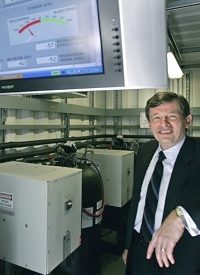
As an investigation unfolds over a controversial U.S. Department of Energy (DOE) loan guarantee program, another "green" loan recipient lingers at the brink of financial collapse. Massachusetts energy firm Beacon Power Corporation, which develops "flywheel-based" energy storage systems, filed for bankruptcy Sunday after receiving a $43 million Energy Department loan guarantee in August 2010 — only months after taxpayers were put on the hook for a $535 million loan guarantee granted to the now-defunct solar energy company Solyndra.
Beacon Power’s bankruptcy filing arrived just two days after the White House ordered a 60-day "independent analysis" of the DOE’s loan program, where officials will evaluate and improve the monitoring process to "ensure" that government leaders are being "strong stewards of taxpayer dollars."
In August 2010, the Treasury Department’s Federal Financing Bank awarded Beacon Power the loan guarantee to finance a new energy storage plant in Stephentown, New York. But the company claims a run of bad fortune has burdened its financial standing, especially after it was delisted by the Nasdaq following an 80-percent plunge in its shares this year. "The current economic and political climate, the financing terms mandated by DOE, and Beacon’s recent delisting notice from Nasdaq have together severely restricted Beacon’s access to additional investments through the equity markets," CEO F. William Capp (pictured above) alleged in papers filed during Sunday’s bankruptcy proceedings.
The filing is expected to feed the fire in what has already become a heated debate over the Energy Department’s authority to disperse taxpayer dollars to companies of its choosing. Solyndra’s controversial demise unleashed a cascade of Republican-led assaults on the department’s loan guarantee program, which is now under investigation in the House Energy and Commerce Committee and the House Oversight and Government Reform Committee.
"This latest failure is a sharp reminder that DOE has fallen well short of delivering the stimulus jobs that were promised, and now taxpayers find themselves millions of more dollars in the hole," asserted Rep. Cliff Stearns (R-Fla.), a sharp critic of the program and the GOP’s leading assailant in the Solyndra investigation. "Unfortunately for the American taxpayers, I am deeply concerned that other DOE programs could follow, which goes to the heart of the President’s flawed economic program."
However, the DOE countered that Beacon’s situation is different, because where Solyndra immediately ceased manufacturing operations when it went bankrupt, Beacon will continue operations at its New York plant. DOE spokesman Damien LaVera claimed the two companies’ loan agreements were structured differently, noting that there are "many protections for the taxpayer" in the Beacon loan agreement. "The Department’s loan guarantee is for the project Stephentown Regulation Services, LLC, not the parent company, and the loan was set up in a way that ensures the Department is not directly exposed to the liabilities of the parent company," LaVera wrote in an email Monday.
But the two loans are under the same program, and just like Solyndra, Beacon was touted by the Obama administration as a leading innovator in green energy technology. The DOE heralded Beacon’s "flywheel" energy storage technology because of its efficacy to improve power grid stability and introduce a sustainable "green" technology solution to mitigate fossil fuel consumption. "We will continue to support the development and deployment of innovative energy systems like this energy storage project that support our goal of expanding renewable energy generation and reducing greenhouse gas emissions," Energy Secretary Steven Chu declared during the finalization process of Beacon’s loan agreement in August of 2010.
Some observers have already noted parallels between the special interests that seemingly littered the Solyndra debacle and a similar kind of cronyism embedded in Beacon’s loan authorization. For instance, Oklahoma billionaire George Kaiser, who reportedly had a heavy hand in Solyndra’s loan authorization, was a prominent Solyndra investor and fundraiser for Obama’s 2008 campaign, raising as much as $100,000 for the President. Mr. Kaiser also visited the White House multiple times in March 2009, according to visitor logs.
Similar to Kaiser’s cozy relationship with Solyndra and the federal government, William Capp and other Beacon Power executives have donated to Obama and other Democratic Party candidates, according to the Center for Responsive Politics. Capp contributed $500 to Obama’s 2008 campaign. He also donated to Democratic Massachusetts Rep. Niki Tsongas and to the defeated Massachusetts Senate campaign of Democrat Martha Coakley, who lost to the Republican underdog Scott Brown in a special election for Sen. Ted Kennedy’s former Senate seat.
Moreover, Beacon government relations director Matthew Polimeno contributed $750 to Rep. Tsongas and $250 to Coakley; the company’s CFO James Spiezio donated $250 to Coakley. All in all, Beacon executives reaped a whopping $17,200 of Energy Department money for every dollar they contributed to the Democratic Party.
Such cronyism may explain why the general public has come to feel such disdain for the federal government’s ambitious role in private sector financing. According to a new survey by Heritage Action for America, nearly three-quarters of voters (72 percent) "oppose the federal government choosing which companies within a certain industry will receive financial subsidies, with a majority (53 percent) strongly opposing." Much of the public’s skepticism has sprung from recent episodes, as 65 percent of respondents believe that Solyndra’s bankruptcy is a "perfect example of why the federal government should not be in the role of picking winners and losers."
Photo: President and CEO of the Beacon Power Corporation, Bill Capp, beside a grid display and flywheels for the Smart Energy Matrix system, Dec. 6, 2005, at a Pacific Gas & Electric facility in San Ramon, Calif.: AP Images



